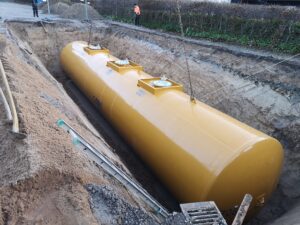 Why a underground tank?
Why a underground tank?
A underground tank is a storage tank that is installed below the ground surface. These tanks are often used to store liquids such as fuel, oil, chemicals, water and sewage. Underground tanks can be single-skinned or double-skinned, depending on the requirements for safety and environmental protection.
Features and Benefits of UndergroundTanks
- Space saving:
Underground tanks save space on the surface, which is an advantage in places with limited space, such as urban areas and commercial properties. - Security:
By placing the tanks underground, the risk of fire and explosions is reduced, especially when storing flammable liquids such as petrol and diesel. - Environmental protection:
Modern underground tanks, especially the double-skinned ones, are designed to prevent leaks and minimize the risk of soil and water contamination. With a properly installed double-skinned underground tank, there is a very minimal risk of leakage. - Aesthetics:
Underground tanks are hidden from view, preserving the aesthetics of the surrounding area, such as in residential areas or commercial locations. - Temperature regulation:
The soil acts as a natural insulator, helping to keep liquids at a stable temperature, which is important for certain chemicals and fuels.
Types of Underground Tanks
- Single-skinned tanks:
Has only a single container (tank wall) and is usually cheaper to manufacture. However, they require extra protective measures to prevent leaks. - Double-walled tanks:
Consists of an inner and outer wall with a gap that can be monitored for leaks. This provides extra security against leaks and contamination.
Areas of application
- Fuel storage:
Used by gas stations and commercial facilities to store gasoline, diesel and other fuels. - Water supply:
Used for storing drinking water or rainwater for later use. - Waste water management:
Used for collecting and storing waste water until it can be treated or transported to a treatment plant. - Storage of chemicals:
Industrial facilities use underground tanks to store chemicals in a safe and controlled manner. - Depot facility / Tank facility:
As a safer alternative to storage facilities above ground, with large space-built tanks. More and more storage facilities are built today with batteries of underground tanks. It is especially with a view to the risk of fire/explosion that it is a big advantage to have underground tanks. However, it also provides more flexibility and less challenges with temperature fluctuations.
Installation and Maintenance
- Installation:
Installation of underground tanks requires careful planning and compliance with local regulations. This includes excavating, placing the tank, connecting pipes and monitoring systems, as well as filling and packing the soil around the tank. - Maintenance:
Regular inspection and maintenance is essential to ensure that the tank is functioning properly and not leaking. This may include monitoring leak detection, checking corrosion and leak testing.
Summary
Underground tanks are an efficient and safe method of storing various liquids below the ground surface. They offer many advantages, including space saving, improved safety, and environmental protection. Correct installation and maintenance are essential to ensure their long-term function and safety.




